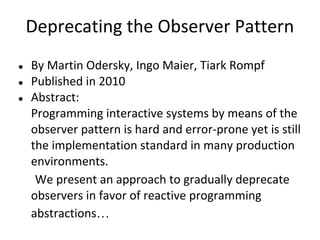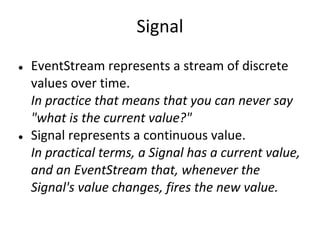Funtional Reactive Programming with Examples in Scala + GWT
- 1. Functional Reactive Programming with Examples in Scala + GWT Sasha Kazachonak kazachonak.com
- 2. Google Web Toolkit Tutorial
- 3. Scala + GWT. Part 1. class StockWatcher extends EntryPoint { val stocksFlexTable = new FlexTable val stocks = new mutable.ArrayBuffer[String]() def onModuleLoad { stocksFlexTable.setText(0, 0, "Symbol") stocksFlexTable.setText(0, 1, "Price") stocksFlexTable.setText(0, 2, "Change") stocksFlexTable.setText(0, 3, "Remove") }
- 4. Scala + GWT. Part 2. private def addStock(symbol: String) { if (stocks.contains(symbol)) return val row = stocksFlexTable.getRowCount stocks += symbol stocksFlexTable.setText(row, 0, symbol) stocksFlexTable.setWidget(row, 2, new Label) val removeStockButton = new Button("x", new ClickHandler { def onClick(event: ClickEvent) = { val removedIndex = stocks.indexOf(symbol) stocks.remove(removedIndex) stocksFlexTable.removeRow(removedIndex + 1) } })
- 5. Scala + GWT. Part 3. private def updateTable(prices: Array[StockPrice]) { prices.foreach(updateTable) } private def updateTable(price: StockPrice) { if (!stocks.contains(price.symbol)) { return } val row = stocks.indexOf(price.symbol) + 1 stocksFlexTable.setText(row, 1, price.price) val changeWidget = stocksFlexTable.getWidget(row, 2).asInstanceOf [Label] changeWidget.setText(price.changePercent + "%")
- 6. github.com/kazachonak/contour class StockWatcherView extends View { val widget = FlexTable(Stock.all)( stock => List( Column("Symbol")(Label(stock.symbol)), Column("Price")(Label(stock.price.toString)), Column("Change")( Label(stock.changePercent + "%") ), Column("Remove")(Button(Stock.all -= stock, "x")) )) private def addStock(symbol: String) { Stock.all += new Stock(symbol)
- 7. Good luck doing it in another language ● No additional variables manipulation ● Much cooler: FlexTable is not fully re-rendered. Just the required rows are updated. ● Model-View synchronization is incapsulated in Reactive Collection implementation and View DSL implementation. ● So it can be reused. No need to synchronize by hand. ● All those abstractions are fully typesafe (indispensable when abstractions are non-trivial) ● Implemented using only standard Scala language features without any magic.
- 8. The essence of functional reactive programming is to specify the dynamic behavior of a value completely at the time of declaration. Heinrich Apfelmus the author of the Haskell library Reactive-banana
- 9. The basic ideas ● Datatypes that represent a value "over time". ● Computations that involve these changing- over-time values will themselves are values that change over time. ● Imagine your program is a spreadsheet and all of your variables are cells. If any of the cells in a spreadsheet change, any cells that refer to that cell change as well.
- 10. The basic ideas. Example. ● You could represent the mouse coordinates as a pair of integer-over-time: x = mouse.x y = mouse.y ● We only need to make this assignment once, and the x and y variables will stay "up to date" automatically. No need to mutate variables. ● Computations based on result in values that change over time: minX = x – 16 minY = y – 16 maxX = x + 16 maxY = y + 16 minX will always be 16 less than the x coordinate of the mouse pointer. ● With reactive-aware libraries you could then say something like: rectangle(minX, minY, maxX, maxY) And a 32x32 box will be drawn around the mouse pointer and will track it. wherever it moves.
- 11. Deprecating the Observer Pattern ● By Martin Odersky, Ingo Maier, Tiark Rompf ● Published in 2010 ● Abstract: Programming interactive systems by means of the observer pattern is hard and error-prone yet is still the implementation standard in many production environments. We present an approach to gradually deprecate observers in favor of reactive programming abstractions…
- 12. Status quo ● Growing number of non-expert computer users ● Increasingly multimedia capable hardware ● Increasing demand in interactive applications ● Such apps require much efforts to deal with continuous user input and output ● Programming models for user interfaces have not changed much ● The predominant approach to deal with state changes in production software is still the observer pattern
- 13. Observers => Bugs ● Quote from Adobe presentation from 2008: ● 1/3 of the code in Adobe’s desktop applications is devoted to event handling logic ● 1/2 of the bugs reported during a product cycle exist in this code ● We claim that we can reduce event handling code by at least a factor of 3 once we replace publishers and observers with more appropriate abstractions. ● The same abstractions should help us to reduce the bug ratio. ● We believe that event handling code on average should be one of the least error-prone parts of an application.
- 14. Mouse Dragging Example var path: Path = null val moveObserver = { (event: MouseEvent) => path.lineTo(event.position) draw(path) } control.addMouseDownObserver{ event => path = new Path(event.position) control.addMouseMoveObserver(moveObserver) } control.addMouseUpObserver{ event => control.removeMouseMoveObserver(moveObserver) path.close() draw(path)
- 15. The observer pattern violates many software engineering principles ● Side-effects ● Encapsulation ● Composability ● Separation of concerns ● Scalablity ● Uniformity ● Abstraction ● Resource management ● Semantic distance
- 16. Let the tutorial begin ● reactive-web.co.cc library written in Scala by Naftoli Gugenheim ● I've modified it to make it work when compiled to JavaScript by Google Web Toolkit: github.com/kazachonak/reactive
- 17. EventStream ● Similar to a collection of values, except that rather than all values existing simultaneously, each one exists at a different point in time. ● Methods in reactive-core are named like the corresponding methods in the scala collections framework.
- 18. Creating an EventStream val eventSource = new EventSource[String] {} scheduleTask(10000) { eventSource.fire("Event after 10 seconds") } val eventStream: EventStream[String] = eventSource val widgets = List(Widgets.EventSourceInput(eventSource), Widgets.EventStreamOutput(eventStream))
- 19. Timer class EventStream_Timer extends Demo { // Create a timer that fires every 2 seconds, // starting at 0, for 30 seconds private val timer = new Timer(0, 2000, {t => t >= 32000}) val widgets = List(Widgets.EventStreamOutput(timer))
- 20. Adding listeners: foreach val eventSource = new EventSource[String] {} //The following is syntactic sugar for // eventSource.foreach(event => // Window.alert("You fired: " + event)) for(event <- eventSource) { Window.alert("You fired: " + event) } val widgets = List(Widgets.EventSourceInput (eventSource))
- 21. EventStream Transformations ● Similar to how you can transform collections: List (1,2,3).map(_ * 10).filter(_ < 25). ● Consumers of the resulting EventStream don't need to care about how it relates to the original EventStream. ● Whenever the original EventStream fires an event, the transformed EventStreams may fire their own events that are based on the original's event, according to the transformation.
- 22. A more focused EventStream: filter val eventSource = new EventSource[String] {} // Only allow short events val eventStream = eventSource.filter(_.length < 5) val widgets = List(Widgets.EventSourceInput(eventSource), Widgets.EventStreamOutput (eventStream))
- 23. A transformed EventStream: map val eventSource = new EventSource[String] {} // Reverse the event val eventStream = eventSource.map(_.reverse) val widgets = List(Widgets.EventSourceInput(eventSource), Widgets.EventStreamOutput(eventStream))
- 24. flatMap val original = List(1, 2, 3) val flatMapped = original.flatMap(x => List(x*10, x*10+1, x*10+2)) flatMapped == List(10,11,12, 20,21,22, 30,31,32) Similarly, flatMap allows you to create an EventStream that fires events that are fired by different other EventStreams.
- 25. Combining EventStreams: | val allClicks = leftClicks | middleClicks | rightClicks
- 26. Signal ● EventStream represents a stream of discrete values over time. In practice that means that you can never say "what is the current value?" ● Signal represents a continuous value. In practical terms, a Signal has a current value, and an EventStream that, whenever the Signal's value changes, fires the new value.
- 27. Signal Examples. val myVal = Val(72) val myVar = Var(31) myVar.change.foreach(println) myVar() = 29 // prints 29
- 28. Signal. map. val myVar = Var(3) val mapped = myVar.map(_ * 10) println(mapped.now) // prints 30 myVar() = 62 println(mapped.now) // prints 620
- 29. Signal. map. val myVar = Var("This is a Var") val mapped = myVar.map(s => "Reversed: "+s.reverse) val widgets = List(Widgets.VarInput(myVar), Widgets.SignalOutput(mapped))
- 30. Signal. flatMap. val myVar1 = Var(72) val myVar2 = Var(69) val myVar3 = Var(false) val flatMapped = myVar3 flatMap { case true => myVar1 case false => myVar2 } println(flatMapped.now) // prints 69 myVar3() = true println(flatMapped.now) // prints 72 myVar2() = 2 myVar1() = 1 println(flatMapped.now) // prints 1 myVar3() = false
- 31. Signal. flatMap. def filteredList(filterSignal: Signal[String], itemsSignal: Signal[List[String]]) = for { filter <- filterSignal items <- itemsSignal } yield items.filter(s => s.indexOf(filter) >= 0)
- 32. SeqSignal[T] extends Signal[Seq[T]] val bufferSignal = BufferSignal(1, 2, 3, 4, 5) bufferSignal.value += 6 // fires an Insert // fires a Remove and an Insert bufferSignal() = List(2, 3, 4, 5, 6, 7)
- 33. Stock.all is SeqSignal[Stock] class StockWatcherView extends View { val widget = FlexTable(Stock.all)( stock => List( Column("Symbol")(Label(stock.symbol)), Column("Price")(Label(stock.price.toString)), Column("Change")( Label(stock.changePercent + "%") ), Column("Remove")(Button(Stock.all -= stock, "x")) )) private def addStock(symbol: String) { Stock.all += new Stock(symbol)
- 34. ?



![Scala + GWT. Part 1.
class StockWatcher extends EntryPoint {
val stocksFlexTable = new FlexTable
val stocks = new mutable.ArrayBuffer[String]()
def onModuleLoad {
stocksFlexTable.setText(0, 0, "Symbol")
stocksFlexTable.setText(0, 1, "Price")
stocksFlexTable.setText(0, 2, "Change")
stocksFlexTable.setText(0, 3, "Remove")
}](https://image.slidesharecdn.com/frp-scala-gwt-121125001735-phpapp02/85/Funtional-Reactive-Programming-with-Examples-in-Scala-GWT-3-320.jpg)

![Scala + GWT. Part 3.
private def updateTable(prices: Array[StockPrice]) {
prices.foreach(updateTable)
}
private def updateTable(price: StockPrice) {
if (!stocks.contains(price.symbol)) {
return
}
val row = stocks.indexOf(price.symbol) + 1
stocksFlexTable.setText(row, 1, price.price)
val changeWidget = stocksFlexTable.getWidget(row, 2).asInstanceOf
[Label]
changeWidget.setText(price.changePercent + "%")](https://image.slidesharecdn.com/frp-scala-gwt-121125001735-phpapp02/85/Funtional-Reactive-Programming-with-Examples-in-Scala-GWT-5-320.jpg)












![Creating an EventStream
val eventSource = new EventSource[String] {}
scheduleTask(10000) {
eventSource.fire("Event after 10 seconds")
}
val eventStream: EventStream[String] =
eventSource
val widgets =
List(Widgets.EventSourceInput(eventSource),
Widgets.EventStreamOutput(eventStream))](https://image.slidesharecdn.com/frp-scala-gwt-121125001735-phpapp02/85/Funtional-Reactive-Programming-with-Examples-in-Scala-GWT-18-320.jpg)

![Adding listeners: foreach
val eventSource = new EventSource[String] {}
//The following is syntactic sugar for
// eventSource.foreach(event =>
// Window.alert("You fired: " + event))
for(event <- eventSource) {
Window.alert("You fired: " + event)
}
val widgets = List(Widgets.EventSourceInput
(eventSource))](https://image.slidesharecdn.com/frp-scala-gwt-121125001735-phpapp02/85/Funtional-Reactive-Programming-with-Examples-in-Scala-GWT-20-320.jpg)

![A more focused EventStream: filter
val eventSource = new EventSource[String] {}
// Only allow short events
val eventStream =
eventSource.filter(_.length < 5)
val widgets =
List(Widgets.EventSourceInput(eventSource),
Widgets.EventStreamOutput
(eventStream))](https://image.slidesharecdn.com/frp-scala-gwt-121125001735-phpapp02/85/Funtional-Reactive-Programming-with-Examples-in-Scala-GWT-22-320.jpg)
![A transformed EventStream: map
val eventSource = new EventSource[String] {}
// Reverse the event
val eventStream = eventSource.map(_.reverse)
val widgets =
List(Widgets.EventSourceInput(eventSource),
Widgets.EventStreamOutput(eventStream))](https://image.slidesharecdn.com/frp-scala-gwt-121125001735-phpapp02/85/Funtional-Reactive-Programming-with-Examples-in-Scala-GWT-23-320.jpg)







![Signal. flatMap.
def filteredList(filterSignal: Signal[String],
itemsSignal: Signal[List[String]]) =
for {
filter <- filterSignal
items <- itemsSignal
} yield items.filter(s => s.indexOf(filter) >= 0)](https://image.slidesharecdn.com/frp-scala-gwt-121125001735-phpapp02/85/Funtional-Reactive-Programming-with-Examples-in-Scala-GWT-31-320.jpg)
![SeqSignal[T] extends Signal[Seq[T]]
val bufferSignal = BufferSignal(1, 2, 3, 4, 5)
bufferSignal.value += 6 // fires an Insert
// fires a Remove and an Insert
bufferSignal() = List(2, 3, 4, 5, 6, 7)](https://image.slidesharecdn.com/frp-scala-gwt-121125001735-phpapp02/85/Funtional-Reactive-Programming-with-Examples-in-Scala-GWT-32-320.jpg)
![Stock.all is SeqSignal[Stock]
class StockWatcherView extends View {
val widget =
FlexTable(Stock.all)( stock => List(
Column("Symbol")(Label(stock.symbol)),
Column("Price")(Label(stock.price.toString)),
Column("Change")(
Label(stock.changePercent + "%")
),
Column("Remove")(Button(Stock.all -= stock, "x"))
))
private def addStock(symbol: String) {
Stock.all += new Stock(symbol)](https://image.slidesharecdn.com/frp-scala-gwt-121125001735-phpapp02/85/Funtional-Reactive-Programming-with-Examples-in-Scala-GWT-33-320.jpg)
